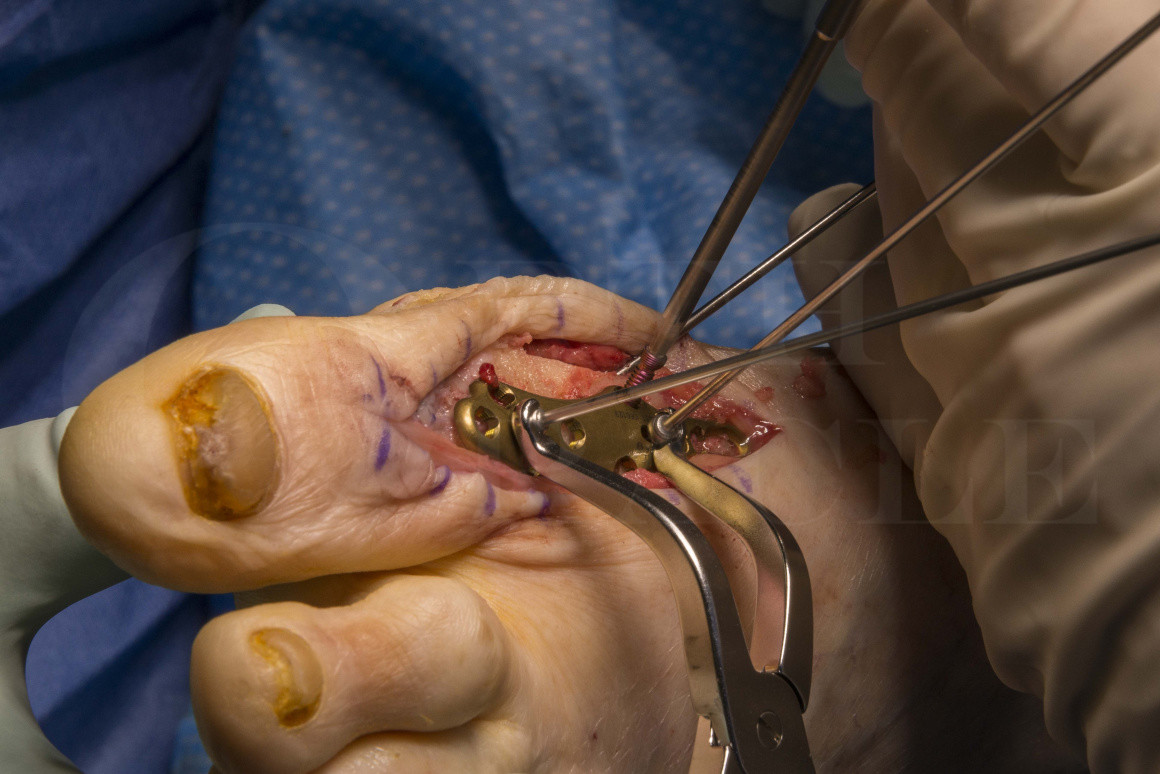Hallux Rigidus: First MTP Fusion, revision of malunion (Synthes MTP fusion plate)
Overview

Subscribe to get full access to this operation and the extensive Foot Surgery Atlas.
Learn the Hallux Rigidus: First MTP Fusion, revision of malunion (Synthes MTP fusion plate) surgical technique with step by step instructions on OrthOracle. Our e-learning platform contains high resolution images and a certified CME of the Hallux Rigidus: First MTP Fusion, revision of malunion (Synthes MTP fusion plate) surgical procedure.
The operation of first metatarsophalangeal joint fusion (1st MTPJ fusion) is the time honoured ‘”gold standard” operation for arthritic conditions of the 1st MTPJ. It offers predictable, low risk good to excellent outcomes and pain relief when successful. The success rates for this operation are high both in enabling function and offering pain relief in up to 95% of patients with hallux rigidus which has failed other treatment such as injection and dorsal cheilectomy .
Non union is rare in well performed primary fusions but they occur due to either biological or mechanical reasons. Mechanical reasons include poor fixation due to implant choice or poor bone quality or patients who do not comply with protected weight bearing post operative protocols and overload the uniting bone. Biological reasons include smokers, patients on drugs such as high dose steroids and anti-inflammatory drugs or patients who suffer early deep infection.
Non-union can present with fibrous tissue bridging the non union, the so called “stable fibrous non union”, and these are relatively asymptomatic especially in a low demand patient such as a rheumatoid arthritis patient. However some non unions are of the atrophic variety and in the presence of insecure or loose/broken metalwork can be very painful needing further fusion especially with worsening deformity and transfer pain in the sole of the foot over the lesser metatarsals.
The indications for revision fusion are in the main either non-union( which is a recognised complication occurring in 5-10% of patients) or malunion, leading to mechanical pain from the lesser toes which are called upon to substitute for the de-functioned hallux.
The technique detailed in this operation is using the Synthes MTP fusion plate, a Dorsal Locking Plate. This plate provides a very strong construct and allows comfortable walking early in the post op period. The Synthes locking plates are low profile, with variable angle locking holes & screws. This allows the screws to be positioned well and avoid any underlying metal work (often found in revision cases). The plate profile is curved for strength and also to fit the anatomy well. The plates come in 3 different angles of dorsiflexion at the MTP joint, 0, 5 & 10 degrees and in 3 different lengths. I most often use the middle length plate (42mm) in 0 degrees of dorsiflexion.
Readers will also find of interest the following OrthOracle techniques:
First MTP fusion (hallux rigidus): Dorsal approach with Synthes MTP fusion plate
First MTP Fusion :Coughlin reamer preparation and Orthosolutions Cannulated 4mm screws.
First MTP Fusion (using Stryker Anchorage MTP arthrodesis plate )for Hallux Varus .
First MTP Fusion: Revision of failed Kellers using DocPrice plate and vascularised allograft.
First MTP Fusion-Crossed screws technique.
Bone block first MTP fusion using the Wright Ortholoc plate
Author: Kartik Hariharan FRCS.
Institution: Aneuran Bevan University Health Board, Wales.
Clinicians should seek clarification on whether any implant demonstrated is licensed for use in their own country.
In the USA contact: fda.gov
In the UK contact: gov.uk
In the EU contact: ema.europa.eu



















